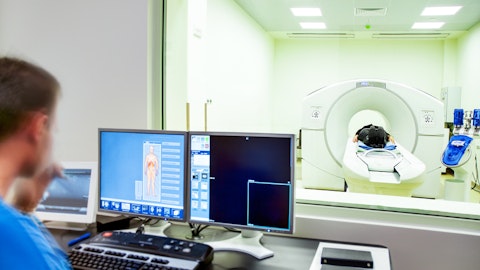CVS Health Corporation (NYSE:CVS) Q2 2023 Earnings Call Transcript August 2, 2023
CVS Health Corporation beats earnings expectations. Reported EPS is $2.4, expectations were $2.12.
Operator: Good morning everyone. My name is Bruno and I will be your conference Operator for today. At this time, I would like to welcome everyone to the CVS Health second quarter 2023 earnings conference call. All lines have been placed on mute to prevent any background noise. After the speakers’ remarks, there will be a question and answer session. If you’d like to ask a question during this time, simply press star followed by one on your telephone keypad. If you’d like to withdraw your question, please press the star followed by two. I will now hand over to your host, Larry McGrath. You may begin your conference.
Larry McGrath: Good morning and welcome to the CVS Health second quarter 2023 earnings call and webcast. I’m Larry McGrath, Senior Vice President of Business Development and Investor Relations for CVS Health. I’m joined this morning by Karen Lynch, President and Chief Executive Officer, and Shawn Guertin, Executive Vice President and Chief Financial Officer. Following our prepared remarks, we’ll host a question and answer session that will include additional members of our leadership team. Our press release and slide presentation have been posted to our website along with our Form 10-Q that we filed this morning with the SEC. Today’s call is also being broadcast on our website, where it will be archived for one year.
During this call, we’ll make certain forward-looking statements. Our forward-looking statements are subject to significant risks and uncertainties that could cause actual results to differ materially from currently projected results. We strongly encourage you to review the reports we file with the SEC regarding these risks and uncertainties, in particular those that are described in the cautionary statements concerning forward-looking statements and risk factors in our most recent annual report filed on Form 10-K, our quarterly reports on Form 10-Q, the most recent of which was filed this morning, and our recent filings on Form 8-K including this morning’s earnings press release. During this call, we’ll use non-GAAP measures when talking about the company’s financial performance and financial condition.
You can find a reconciliation of these non-GAAP measures in this morning’s press release and in the reconciliation documents posted to the Investor Relations portion of our website. With that, I’d like to turn the call over to Karen. Karen?

Karen Lynch: Thank you Larry. Good morning everyone and thanks for joining our call today. CVS Health closed another successful quarter, delivering on our financial commitments through the power of our diversified business model and focused execution of our strategy. We have been relentless in the pursuit of our goals to deliver superior health experiences by improving outcomes, lowering costs, driving higher levels of engagement, and broadening access to high quality care. So far in 2023, we have achieved several key accomplishments. First, we acquired Signify Health and Oak Street Health, two best-in-class value-based care assets. We are making progress integrating these multi-payor companies to create meaningful value. We are unlocking opportunities by connecting Signify and Oak Street to CVS Heath assets such as Aetna, MinuteClinic, and CVS Pharmacy, and driving patient engagement and growth.
As we scale our healthcare delivery assets and realize synergy opportunities, we will accelerate our long term growth trajectory. Second, we expanded our individual exchange offering to 12 states and successfully on-boarded more than one million new members. Strategically, this is an important marketplace that grew to approximately 50 million enrollees in 2022. Our success with this population lays the foundation for future earnings growth at Aetna and creates connection for these members across all our integrated assets. Finally, our ability to generate strong cash flows enables us to invest in our long term strategy and return value to shareholders. Through June 30, we generated more than $13 billion of operating cash flow and returned more than $3.5 billion to our shareholders.
We expect to continue to return cash to our shareholders and deploy capital to enhance shareholder value. Today we reported second quarter adjusted EPS of $2.21 and adjusted operating income $4.5 billion. Our diversified business strengthened by our exceptional execution positions us to navigate emerging headwinds in Medicare Advantage and a changing consumer environment. We are reaffirming our full year 2023 adjusted EPS guidance range of $8.50 to $8.70. Shawn will provide more details on our updated outlook for the year shortly. Turning to our performance highlights for the quarter, in our healthcare benefits segment, we grew revenues to $26.7 billion, an increase of nearly 18%, and delivered adjusted operating income of $1.5 billion. Medical membership in the second quarter was 25.6 million, an increase of 1.2 million members versus the prior year, reflecting broad-based growth including individual exchange, Medicare and commercial membership.
For our core commercial membership, this quarter marks the eighth consecutive quarter of membership gains. This growth reflects our differentiated product offerings that address the total cost of care and the whole health of a member through our integrated solutions. Medical cost trends were well controlled in our commercial and Medicaid books of business. Consistent with the broader industry, elevated medical costs emerged in our Medicare Advantage business which became apparent in the latter part of the quarter. The primary driver of these elevated medical costs was greater than expected utilization in outpatient settings. Shawn will discuss these trends in more detail. In Medicaid, the State of Oklahoma awarded us a new statewide Medicaid contract beginning in April 2024 that will add approximately 200 members.
This win demonstrates our market-leading ability to comprehensively support Medicaid populations through our deep local relationships, investment in clinical programs, and integrated wellbeing solutions. This quarter, we were able to offset the pressures in our healthcare benefits segment with continued strong execution in our health services segment. Revenues grew to $46.2 billion, an increase of nearly 8%. Adjusted operating income grew 3.5% to $1.9 billion. These results were driven by our pharmacy services business. We consistently demonstrate value to consumers and our clients by successfully managing drug cost trends and bringing innovative clinical solutions to the market. In the second quarter, branded drug revenue increased in part driven by the GLC1 category.
This expensive and fast-growing category presents new choices for the over 70 million adults in the U.S. who are living with obesity and the nearly 37 million people who have Type 2 diabetes. We are well positioned to deliver value to customers in this category with our weight loss programs and utilization management tools that drive the lowest net cost for our clients. Every day, we create competition, drive the lowest net cost, and deliver transparency, value and choice to our customers. This is the foundation of our continued success and our market-leading position. Turning to healthcare delivery, both Signify Health and Oak Street Health had strong quarters, delivering business performance consistent with our expectations. These assets bring core capabilities to our multi-payor value-based care platform that drives optimal patient engagement with health services across multiple channels.
In the short time since we closed these transactions, we’ve launched efforts to drive high patient engagement by leveraging our CVS Health assets. Signify Health is core to our home health services strategy. Signify enables better health in the home and has an unmatched ability to build trust and connect with 3 million patients in their homes annually. We capture valuable insights into a patient’s broader care needs during in-home evaluations and are able to create engagement points across other health services for our health plan partners. These engagement points ultimately drive better care, lower the total cost of care such as reducing hospital readmissions, and improving health outcomes. Survey results show that members who are highly satisfied with their Signify in-home evaluations are 26 times more likely to recommend their health plan and 74% more likely to consider additional health services.
Signify’s customers recognize the power of this trusted relationship and the value of these home services. Since the close of the acquisition, Signify has demonstrated exceptional retention of its health plan and health system customers. We’ve added new relationships, expanding the opportunity to bring Signify’s services to more Medicare members. CVS Health’s trusted brand and our broad customer touch points further increase opportunities for Signify to engage with patients and expand the services they deliver. This quarter, there is a strong demand for both in-home evaluations and additional Signify services in the home. We launched new member engagement initiatives at select CVS pharmacies to drive IET conversion of Aetna Medicare members and CVS pharmacy customers to Signify.
Early results are promising with higher engagement across the CVS Health channels utilized. Turning to Oak Street Health, we are accelerating patient growth through our broad community presence and ability to engage consumers across multiple channels. Today there are approximately 1 million Medicare-eligible seniors who visit CVS pharmacies each week that are located near an Oak Street clinic. We launched new member engagement initiatives focused on creating connections between Medicare-eligible CVS customers, both in store and digitally, and Oak Street Health providers. We are also connecting Aetna Medicare members who are currently without a primary care physician with their local Oak Street provider to re-engage them in their care. These initiatives will drive Oak Street patient growth and accelerate the path to mature clinic profitability while broadly serving the needs of Medicare members.
As Oak Street expands to additional geographies, these opportunities to drive higher patient growth will continue to increase. By the end of 2023, we expect to have Oak Street clinics in 25 states, up from 21 at the close of the transaction. We will also open new Oak Street clinics co-located with CVS pharmacies this year and have already identified additional locations for 2024. We now expect to build 50 to 60 clinics next year. Turning to our pharmacy and consumer wellness segments, we grew revenues to $28.8 billion, an increase of nearly 8% versus the prior year. We generated $1.4 billion of adjusted operating income in the quarter, a decrease of 17% from the prior year largely due to lower COVID-related volumes. Our pharmacy business delivered another quarter of strong performance.
Same store pharmacy sales increased by more than 14% versus the prior year, primarily driven by pharmacy drug mix and brand inflation. Same store prescription growth when excluding the impact of COVID grew by nearly 5%. This growth is fueled by our efforts to provide a differentiated omnichannel pharmacy experience that meets customers where they are In our front store, we’ve grown market share, increased household penetration, and delivered historically high service levels. This positions us well to manage through economic volatility. In the quarter, our same store sales excluding OTC test kits grew by more than 1%, demonstrating the resiliency of our front store offerings in a more challenging consumer environment. We also continue to make progress growing our digital members and sales.
This quarter, we exceeded 53 million unique digital customers, up over 2 million from last quarter. Our digital sales increased 24% versus the prior year, including a meaningful increase of 65% in our over-the-counter health solution offering. This offering is highly valued by our health plan members, allowing them to conveniently access their important OTC benefits. Last quarter, we discussed optimizing our cost structure. This morning, we announced a restructuring charge of nearly $500 million associated with the elimination of approximately 5,000 non-customer facing positions as well as the impairment of non-core assets. These efforts are expected to generate over $600 million of run rate savings beginning in 2024. Our optimization efforts have also focused on identifying additional opportunities to drive efficiency and operational excellence using technology.
For example, we’ve been selectively using artificial intelligence for some time and are increasingly finding opportunities to improve the efficiency of our operations, enhance our customer experience, and increase our competitiveness. When combining all of our productivity initiatives, we are confident we will achieve the $700 million to $800 million of cost savings that we are targeting in 2024. These actions enable us to reallocate resources and invest in critical growth areas such as health services and technology, which are the biggest enablers of our strategy. We’ve taken meaningful steps executing on our long term strategy with tangible proof of the value of our unique integrated offerings. We look forward to providing more details at our investor day on December 5 in Boston.
I’ll now turn the call over to Shawn to provide a deeper look into our results and our guidance. Shawn?
See also 20 Most Profitable Pharma Companies and 15 Cheapest and Safest Countries to Retire In
Shawn Guertin: Thank you Karen, and good morning everyone. Our second quarter results continued to demonstrate the strength of our execution and the power of our diversified enterprise. We delivered strong revenue growth, adjusted earnings per share and cash flow from operations. A few highlights regarding total company performance. Second quarter revenues of nearly $90 billion increased by more than 10% year-over-year, reflecting strong growth across each of our businesses. We delivered adjusted operating income of nearly $4.5 billion and adjusted EPS of $2.21, representing decreases of approximately 10% and 13% versus prior year respectively. These decreases were primarily due to declines in our healthcare benefits and pharmacy and consumer wellness segments, partially offset by strong execution in our pharmacy services operations.
Our ability to generate cash remains outstanding with year-to-date cash flow from operations of $13.3 billion. These cash flows were impacted by the timing of CMS payments that are expected to normalize in the fourth quarter. Excluding this impact, our cash flows from operations remain strong at $8 billion. Shifting to the details for our healthcare benefits segment, we delivered strong revenue growth versus the prior year. Second quarter revenue of $26.7 billion increased by 17.6% year-over-year, reflecting growth across all product lines. Membership grew to 25.6 million, an increase of 121,000 members sequentially, reflecting increases in our individual exchange and commercial businesses partially offset by the impact of Medicaid redeterminations.
Adjusted operating income of $1.5 billion in the quarter declined approximately 20% versus the prior year. This decline was driven by a higher than expected medical benefit ratio partially offset by higher net investment income and strong execution on operating cost management. Our medical benefit ratio of 86.2% increased 350 basis points year-over-year, reflecting higher than expected Medicare Advantage utilization in the second quarter. These trends were primarily driven by higher utilization in the outpatient setting as well as dental and behavioral health. We also recognized higher utilization levels in the first quarter and prior year, resulting in lower year-over-year prior period development in the quarter. It is important to note that utilization in our other lines of business, including individual exchange, commercial and Medicaid remain generally in line with our pricing expectations.
Days claims payable at the end of the quarter was 46.9, down 1.2 days sequentially. This decline was almost entirely driven by the impact of increased Medicaid pass-through payments in the quarter. Excluding this impact, DCP was stable and overall we remain confident in the adequacy of our reserves. Our health services segment, which includes our pharmacy services business, and our healthcare delivery operations generated revenue of approximately $46.2 billion, an increase of 7.6% year-over-year. This increase was driven by pharmacy drug mix, growth in specialty pharmacy, brand inflation and the addition of Signify and Oak Street. These increases were partially offset by the impact of continued client price improvements. Adjusted operating income of nearly $1.9 billion grew 3.5% year-over-year, primarily driven by strong execution and improved purchasing economics, partially offset by ongoing client price improvements and lower MinuteClinic COVID-19 testing.
Total pharmacy claims processed in the quarter declined by approximately 1% versus the prior year and down 50 basis points when excluding COVID-19 vaccinations. This decline was primarily attributable to the New York Medicaid carve-out largely offset by net new business. Total pharmacy membership was approximately 110 million members. Within our health services segment, we are very encouraged by the performance and growth of our healthcare delivery assets. Signify completed 673,000 in-home evaluations in the quarter, an increase of 16% versus the same period last year, and generated revenue growth of 19%. Oak Street ended the quarter with 177 centers and 181,000 at-risk lives, increases over the same period last year of approximately 23% and 35% respectively.
Oak Street also significantly increased revenue in the quarter, growing 43% compared to the same quarter last year. Moving to our pharmacy and consumer wellness segment, we generated revenue of $28.8 billion, up nearly 8% versus the prior year and nearly 11% on a same store basis, reflecting the impact of pharmacy drug mix, increased prescriptions and brand inflation. These increases were partially offset by the impact of recent generic introductions, decreased COVID-19 related volume, and continue reimbursement pressure. Adjusted operating income of $1.4 billion declined approximately 17% versus the prior year, driven by reimbursement pressure, lower COVID-19 vaccines and testing, and lower front store volumes. These decreases were partially offset by increased prescription volume and improved generic drug purchasing.
Same store pharmacy sales were up more than 14%, driven by drug mix, a 3.6% increase in same store prescription volumes, and brand inflation. The increase in same store prescription volumes excluding the impact of COVID-19 vaccinations was 4.9%. As Karen mentioned, our front store business is not immune to trends in the broader economy, but we have shown resiliency in the face of these challenges and continue to demonstrate the value we offer consumers. Same store sales for the front store were down 30 basis points primarily due to declines in cough, cold and flu and to OTC test kits. Excluding the impact of OTC test kits, same store front store sales were up by more than 1%. Turning to the balance sheet, our liquidity and capital position remain excellent.
Our ability to generate cash flow has always been a strength of our organization, and the enterprise continues to identify new opportunities to optimize our balance sheet. Through the second quarter, we generated cash flow from operations of $13.3 billion, bolstered by the CMS prepayment I discussed earlier, and ended the quarter with approximately $3.3 billion of cash at the parent and unrestricted subsidiaries. During the quarter, we issued approximately $5 billion of long term debt and repaid our outstanding $5 billion term loan that was used to fund a portion of the Oak Street transaction. Through our quarterly dividend, we returned $795 million to shareholders. We remain committed to maintaining our current investment-grade ratings while preserving flexibility to deploy capital strategically.
A few other items worth highlighting for investors. We recognized acquisition-related transaction and integration costs associated with the Signify and Oak Street transactions as well as additional office real estate optimization charges in the quarter for a total of $168 million. As Karen mentioned in her prepared remarks, we also took a restructuring charge of nearly $500 million associated with our cost optimization efforts and the impairment of non-core assets. Turning now to our outlook for 2023, we are reaffirming our adjusted earnings per share guidance of $8.50 to $8.70. This guidance reflects our performance through the second quarter as well as a higher than expected Medicare Advantage medical cost trend for the remainder of 2023, offset by strength in our pharmacy services business within our health service segment.
In the healthcare benefits segment, we now expect our 2023 medical benefit ratio to fall at the high end of our previous range of 84.7% plus or minus 50 basis points, reflecting the impact of higher Medicare Advantage utilization. While there is uncertainty surrounding the duration of this utilization spike, our 2023 guidance now prudently assumes that these medical cost trends will remain elevated for the rest of 2023. This update also results in a change to our guidance for adjusted operating income, which we now expect to fall in a range of $5.99 billion to $6.12 billion. While we are encouraged by trends in our individual exchange business, this guidance continues to reflect a prudent and cautious stance for that business. In our health services segment, our updated adjusted operating income guidance is a range of $7.11 billion to $7.23 billion, reflecting the strong execution year-to-date in our pharmacy services business and our expectation of continued strength for the remainder of the year.
Developments in our 340B business continue to align with the guidance we provided on our first quarter call. In our pharmacy and consumer wellness segment, we now expect adjusted operating income in a range of $5.63 billion to $5.73 billion. This updated guidance reflects strong fundamental execution year-to-date while recognizing the potential for a weakening consumer environment. Shifting to our cash flow, we continue to anticipate strong full year 2023 cash flow from operations in a range of $12.5 billion to $13.5 billion. As a result of prioritization of our portfolio to optimize our cost structure, we now expect capital expenditures in a range of $2.6 billion to $2.8 billion. We continue to maintain our projections for interest expense and share count, and finally we now project our adjusted effective tax rate at 25.3%.
You can find additional details on the components of our updated 2023 guidance on our Investor Relations webpage. Before concluding my prepared remarks, I would like to address our medium term growth projections and targets. As Karen touched on in her remarks, CVS Health benefits from the diversity of our operations, and this positions us well to be resilient in the face of adversity. We take our commitments seriously, as evidenced by the announcement this morning of our cost cutting initiative which will meaningfully improve our positioning for 2024. However, given the emergence of multiple potential headwinds across our diverse set of assets, including uncertainty in Medicare Advantage, the potential for a weakening consumer environment and reduced retail contributions from COVID, combined with our plans to accelerate Oak Street clinic growth, our 2024 adjusted EPS target of $9 is no longer a reasonable starting point for our guidance range.
Given the more challenging outlook for 2024 and our desire to set guidance that is achievable with opportunities to outperform, we now believe investors should anchor their initial expectations for our 2024 adjusted EPS to $8.50 to $8.70, essentially flat to our existing 2023 guidance range. As is our convention, this guidance does not assume any prior year reserve development. Given the level of uncertainty for 2024, we also believe investors should no longer rely on our 2025 adjusted EPS target of $10. We will provide more clarity on our longer term earnings growth outlook at our investor day in December. While emerging headwinds have created uncertainty for our 2024 and 2025 outlook, make no mistake – we are more convinced than ever in our long term strategy.
The power of our integrated model and care delivery assets will change how consumers and patients engage with the health system and how they receive care. We believe this will benefit customers, patients, payors, and ultimately our shareholders. To conclude, our second quarter results continue to demonstrate the power of our diversified enterprise and the resiliency of our businesses. We continue to maintain our focus on growth and operational execution as we work to become the leading health solution company for consumers. With that, we will now open the call to your questions. Operator?
Q&A Session
Follow Cvs Health Corp (NYSE:CVS)
Follow Cvs Health Corp (NYSE:CVS)
Operator: [Operator instructions] Our first question comes from AJ Rice from Credit Suisse. AJ, your line is now open. Please proceed.
AJ Rice: Thanks, hi everybody. I know Karen teed it up and you mentioned it a couple times, Shawn, taking into account changing consumer backdrop and then the MA uncertainty. Just on that, it sounds like on the consumer changing, you’re signaling about the cough, cold and flu being somewhat soft, but I wouldn’t necessarily think that’s related to the economy. Are you specifically seeing something that’s impacting your business from the consumer at this point in the retail side, or are you just anticipating that? Then on the MA, obviously you gave guidance on the benefits in the back half of the year, MLR, but what is your thinking about how some of the things you’re seeing might impact Oak Street, and can you comment on your ’24 bids and whether they incorporate some caution around utilization?
Karen Lynch: Hey AJ. A couple of things on consumer, and I’ll ask Michelle to talk a little bit. But as we saw June kind of emerge and predicting for this economic volatility and a potential recession, we saw a little bit of pull-back in consumer behavior in June, so we are reflecting that in our forward-looking approach. I can have Michelle talk a little bit about what we saw and then I’ll turn it back to Shawn to talk about the numbers.
Michelle Peluso: Yes, and just above on Karen’s point, we had another solid quarter. It was a market share gain quarter again for the front store. We saw stronger household penetration and historically high net promoter scores, so I think out of an abundance of caution, we’re just looking at slightly softening consumer demand in the back part of the quarter, along with comping historically high cough, cold and flu. I will say though, of course, the strength is coming from the investments we’re making in omnichannel and our merch mix and service and simplifying pricing and promotion. We’re right-sizing our cost structure with our store footprint, our distribution footprint, improving inventory turns, and we’re really excited and [indiscernible] about the work we’re doing with Oak Street Health and Signify to introduce more seniors and more Medicare-eligible customers to the great offerings that Signify and Oak Street Health have in the community.
Shawn Guertin: There’s a lot there, AJ, in your question, so let me try to cover the ground as thoroughly as I can, and I will have both Dan and Mike actually talk about respectively what we saw in Aetna and HCB. As I mentioned in the prepared remarks, RMBR was up 350 basis points year-over-year. It’s really important to look at and recall that last quarter, we said that we expected Q2 MBR to be up year-over-year. One of the main drivers in that is we printed 82.7 last year in the second quarter, so there’s a lot to do here with the starting point. Having said that and allowing for that, Q2 did end up coming in higher than we expected, and the real driver here is Medicare Advantage. It’s also important to keep in mind that Medicare is more than 50% of our premium revenue now.
As I stated, I want to be clear that commercial, Medicaid and exchange all performed consistent or even slightly better than our expectations in the quarter, but as we closed the month of May, in mid-June it became apparent that the Medicare costs were higher than we had anticipated in Q1, and that pressure was continuing into the second quarter. The real driver remains the outpatient categories that we and others have been discussing. Let me have Dan talk a little bit about what we saw in Aetna and I’ll have Mike follow that up with what we saw in Oak Street, and then I’ll come back and talk a little bit about how we’ve prepared our guidance for ’23 and ’24 in light of this.
Dan Finke: Yes, thanks Shawn. I think it’s important to note that our commercial and Medicaid lines of business were largely in line with expectations, and as reported more broadly in the industry, we did experience higher than anticipated outpatient utilization in Medicare. This is likely due to some of these services that have been postponed by our seniors not feeling comfortable accessing the healthcare system during the pandemic. You can think about this as outpatient orthopedic procedures, hips and knees, some cardiac procedures, a little bit of increase in dental, and we’re still seeing some continued levels of elevated mental health use. Again, specific to Medicare and outpatient services, our inpatient volumes remain lower than our normalized levels, and that’s the same across all lines of business, so it’s something we’re closely watching.
Mike Pykosz: From an Oak Street perspective, we’ve seen similar trends on medical costs with outpatient being up across our payor partners. Specifically, though, we’ve had a really strong start to the year on [indiscernible] execution at Oak Street, and so we’ve been able to largely offset the increased outpatient costs through a roughly 4% reduction year-over-year in admissions per thousand, so we’re able to offset the increase in outpatient with continued strong performance in keeping our patients out of the hospital and decreasing inpatients.
Shawn Guertin: Great, so turning back to ’23 first, as I mentioned, Medicare did come in probably about 220 basis points worse than expected for the quarter. Given the way costs have emerged, it’s more instructive to look, I think, at the first half of the year, which is off 100, 110 basis points versus our guidance expectation. As Dan mentioned, there are aspects that some of this could be from a pent-up demand bubble involving discretionary and deferrable services, which if true, would potentially its course and lessen over time, and some preliminary July data does show some of that improvement. However, at this stage in the absence of any compelling evidence to the contrary, we think it’s appropriate to be cautious in our outlook and have assumed that the 100 basis points of pressure observed in the first half of ’23 persists through the second half of the year.
The result of this is what I mentioned in my prepared remarks, that the HCB MBR would be up about 50 basis points at the high end of our guidance range. In terms of 2024, 2024 will come down to two things: where does the 2023 year settle out, which serves as the baseline to go into 2024, and then what level of trend do we experience off that baseline. Our 2024 MA bid did contemplate a degree of higher utilization, but if trends persist at the levels we’ve experienced in the first half as contemplated in our current guidance, we will have already consumed that higher utilization assumption. If a higher level of medical cost trend then persists again in ’24 or, said differently, if we don’t see an abatement in medical cost trend, we would then be pressured on our bid assumptions.
In the absence of a clear indicator that utilization is abating and out of an abundance of caution, our revised 2024 guidance assumes that we have an incremental headwind in 2024 over our revised 2023 guidance baseline. To the extent utilization does abate and costs develop more favorably in 2023 than we project, that could serve as upside to our outlook for both 2023 and 2024.
AJ Rice: Okay, great. Thanks so much.
Operator: Our next question comes from Lisa Gill from JP Morgan. Lisa, your line is now open. Please proceed.





